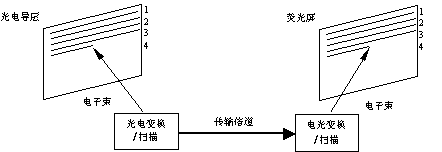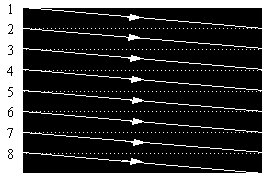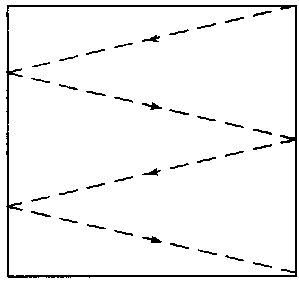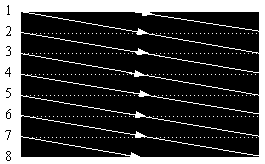Principles of TV Scanning Technology Television technology uses the photoelectric conversion principle to realize the conversion of optical images into television signals. This conversion process is usually completed in the camera. When the subject is imaged on the photoconductive layer of the camera tube through the camera lens, different points on the photoelectric target excite different numbers of photoelectrons with different illuminances, thereby causing different additional photoconductors to produce different potential fluctuations, forming a photo image Corresponding electrical image. Using the visual inertia of the human eye, the physical quantities representing the pixels in the image can be transmitted one by one in a certain order at the sending end, and the original image is reproduced according to the same rules at the receiving end. As long as this sequence is carried out fast enough, the human eye will feel the image shining at the same time. In television technology, this established law of transmitting images is called scanning. As shown in Figure 07-02-5, the electrical image formed in the photoconductive layer of the camera tube turns on each point sequentially under the scanning of the electron beam, and continuously converts their brightness changes into electrical signals; After the electrical signal is transmitted through a single channel, the fluorescent screen with electro-optic conversion characteristics is scanned with an electron beam to convert the electrical signal into an optical image. Figure 07-02-5 Scanning principle of TV system Under normal circumstances, the electric vacuum cameras and imaging devices commonly used in television systems currently use electron beam scanning to achieve photoelectric and electro-optic conversion; and with the use of CCD cameras and flat panel display devices, various pulse digital circuits are used. The above conversion can be achieved. Figure 07-02-6 is a schematic diagram of the scanning processing of a cathode ray tube (CRT), in which the video signal is composed of luma and chroma signal components, and the component video sends out the luma and chroma signals, respectively. Figure 07-02-6 Schematic diagram of cathode ray tube (CRT) scanning process There are two types of scanning methods: progressive scanning and interlaced scanning. The method of sequentially scanning the electron beam from left to right and from top to bottom is called progressive scanning. The linear bright spot trajectory formed by the sequential scanning of the electron beam is called a raster, and the schematic diagram of the raster formed by progressive scanning is shown in Figure 07-02-7. (1) Line scanning: The scanning of the electron beam in the horizontal direction is called line scanning. The scan from left to right is called line scan forward, or line scan for short, as shown by the solid line in Figure 07-02-7 (a). Scanning from right to left is called line scan inverse, or line retrace for short. As shown by the dotted line in 07-02-7 (a). The line scan has a long forward travel time and a short reverse travel time. Obviously, for each image, the more scanning lines, the higher the resolution of the image, the finer the image; but at the same time, the wider the TV signal bandwidth, the higher the channel requirements. (2) Frame scanning: The scanning of the electron beam in the vertical direction is called frame scanning. The scan from top to bottom is called frame scan forward, referred to as frame forward scan, and the scan from bottom to top is called frame scan reverse, referred to as frame retrace. Figure 07-02-7 (a) shows the scan trajectory of the frame scan forward, and Figure 07-02-7 (b) shows the retrace trajectory of the frame scan reverse. Similarly, the frame scan forward travel time is much greater than the frame scan reverse travel time. In fact, the line scanning and the frame scanning are performed simultaneously, that is, the electron beam moves in the vertical direction L while scanning in the horizontal direction, then the movement trajectory of the electron beam is the combined motion of the horizontal and vertical directions. Since the scanning speed of the electron beam in the horizontal direction is much higher than that in the vertical direction, a horizontal bright line slightly obliquely downward is formed on the fluorescent screen, and hundreds of rows of densely scanned bright lines form a uniform grid-like light emitting surface, which is called Raster. One frame is a progressive scan. (a) (b) Figure 07-02-7 Schematic diagram of progressive scanning raster The disadvantages of progressive scanning: to make the image continuous without flickering, it needs to change frames 50 times per second, that is, the frame frequency is 50Hz, but the bandwidth of the image signal is too wide, which complicates the TV equipment. In order to compress the bandwidth of the image signal and at the same time to overcome the flicker phenomenon, the interlaced scanning method has been proposed for the film technology. Current radio and television use interlaced scanning. 2. Interlaced scanning Interlaced scanning is to divide a frame of image into two fields for scanning. The first field scans odd lines, which is called odd field, and the second field scans even lines, which is called even field. Odd and even field images are mosaiced together to form a complete image, as shown in Figure 07-02-8. Figure 07-02-8 Schematic diagram of interlaced image reproduction The interlaced raster is shown in Figure 07-02-9. After scanning the first line, the electron beam returns to the beginning of the third line and then scans, as shown in Figure 07-02-9 (a), and then at the fifth , 7, ..., line scan up to the last line. After scanning the odd lines, scan the even lines (Figure 07-02-9 (b)), so that a frame scan is completed (Figure 07-02-9 (c)). It can be seen from this that an interlaced image consists of two parts: one part is composed of odd lines, called an odd field, and the other part is composed of even lines, called an even field, which together form a frame on two occasions. Therefore, in interlaced scanning, whether it is a camera or a display, an image must be scanned twice to obtain a complete image (Figure 07-02-8). (A) Odd field (b) Even field (C) An interlaced frame Figure 07-02-9 Schematic diagram of interlaced scanning raster In interlaced scanning, the number of lines scanned must be odd. As described above, one frame of picture is divided into two fields, the first field scans half of the total lines, and the second field scans the other half of the total lines. Interlaced scanning requires that the first field ends at half of the last line. No matter how the electron beam is folded back, it must return to the center of the top of the display screen, so that it can ensure that the adjacent second field scan is exactly embedded in the scan lines of the first field intermediate. It is for this reason that the total number of rows must be odd. For interlaced scanning, in order to make the transmitted moving image feel continuous without flickering, it needs to scan 50 fields per second, ie the field frequency is 50 Hz. While two fields are one frame, 25 frames per second are scanned, that is, the frame rate is 25 Hz, thereby reducing the frame rate, compressing the bandwidth of the image signal, and overcoming the flicker phenomenon. The number of lines scanned per second is called line frequency fH; the number of fields scanned per second is called field frequency fc; the number of frames scanned per second is called frame frequency fF. fc and fF are two different concepts. Both black-and-white TVs and color TVs use interlaced scanning, while computers generally use non-interlaced scanning when displaying images.
100% authentic best 18650 cells, below is our regular inventory list:
authentic sony li ion battery cells
18650 Battery,Best 18650 Battery,18650 Lithium Battery,18650 Lithium Ion Battery Asarke Industry Co., Limited , https://www.asarke-industry.com






US18650VTC5A 2500mAh 30Adischarge
US18650VTC5 2500mAh 20Adischarge
US18650VTC4 2100mAh 30Adischarge
US18650V3 2200mAh 10Adischarge E bike cells
US18650VC7 3400mAh 5A/8Adischarge
US18650NC1 2900mAh 10Adischarge E bike cells
US454261A8T 1590mAhlipo cells
Original Sanyo cells:
NCR18650BF 3400mAh
NCR18650GA 3450mAh 10AdischargeE bike cells
UR16650ZTA 2500mAh
UR18650ZTA 4.35V 3000mAh
UR18650FJ 2100/2200mAh red top
UR18650FM 2500/2600mAh blue head
UR18650FK 2300/2400mAh green top
UR18650ZY 2450/2550mAh Made In Japan
UR18650ZY 2450/2550mAh
UR18650AY 2150/2250mAh white head
UR14500P 830mah
UR18500F(K) 1620/1700mAh
UR18650NSX 2600mAh 20Adischarge
UF103450PN 1880/2000mAh with fuse
UF103450PN 1880/2000mAh no fuse
UF463450F
UF703450 1430/1480mAh
UF653450 1250/1300mAh
UF624447F 1530mAh
UF553450ZP 1150/1200mAh
UF553450ZP 1150/1200mAh
UF553443ZU 1000mAh
UF463048F
UF553436G
Authentic Panasonic cells:
NCR18650B3 3400mAh
NCR18650A 3100mAh
NCR18650BM 3200mAh
NCR18650 2900mAh
NCR18650PF 2900mAh 10AdischargeE bike cells
NCA103450 2350mAh no breaker
NCA903864 3120mAh
NC-1900SCR
NCR18500A 1940/2040mAh
NCR18650GA 3450mAh 10AdischargeE bike cells
Original Samsung li ion cells:
INR18650-25RM 2500mAh 20Adischarge
INR18650-25RM 2500mAh 20Adischarge
INR18650-25R 2500mAh 20Adischarge,
INR18650-20RM 2000mAh 22Adischarge
INR18650-30Q 3000mAh 15Adischarge
ICR18650-30B 4.35V 3000mAh
INR18650-35E 3500mAh 10Adischarge
INR18650-29E 2900mAh 8.25Adischarge
INR18650-32E 3200mAh 10Adischarge
ICR18650-22P 2150mAh 10Adischarge
ICR18650-22PM 2150mAh 10Adischarge,
ICR18650-22F 2200mAh
ICR18650-22FM 2200mAh
ICR18650-26JM 2600mAh
ICR18650-26FM 2600mAh
ICR18650-26HM 2600mAh
Original LG cells:
INR18650HE4, 2500mAh 20Adischarge
INR18650F1L, 3400mAh
ICR18650S3, 2200mAh,
ICR18650B4/B4L, 2600mAh
ICR18650MF1/MF2,2200mAh,10Adischarge
ICR18650M26,2600mAh, 10Adischarge
INR18650MG1 2900mAh 10Adischarge
INR18650MH1 3200mAh 10Adischarge
INR18650MJ1 3500mAh 10Adischarger